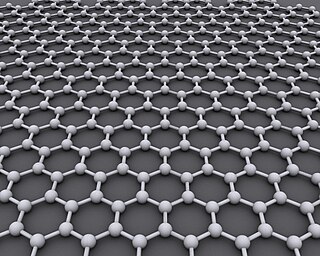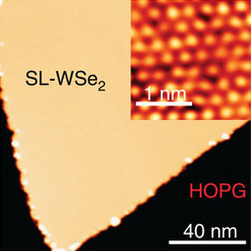Related Research Articles

Graphene is an allotrope of carbon consisting of a single layer of atoms arranged in a hexagonal lattice nanostructure. The name is derived from "graphite" and the suffix -ene, reflecting the fact that the graphite allotrope of carbon contains numerous double bonds.

In physics, topological order is a kind of order in the zero-temperature phase of matter. Macroscopically, topological order is defined and described by robust ground state degeneracy and quantized non-Abelian geometric phases of degenerate ground states. Microscopically, topological orders correspond to patterns of long-range quantum entanglement. States with different topological orders cannot change into each other without a phase transition.

Tungsten ditelluride (WTe2) is an inorganic semimetallic chemical compound. In October 2014, tungsten ditelluride was discovered to exhibit an extremely large magnetoresistance: 13 million percent resistance increase in a magnetic field of 60 tesla at 0.5 kelvin. The resistance is proportional to the square of the magnetic field and shows no saturation. This may be due to the material being the first example of a compensated semimetal, in which the number of mobile holes is the same as the number of electrons. Tungsten ditelluride has layered structure, similar to many other transition metal dichalcogenides, but its layers are so distorted that the honeycomb lattice many of them have in common is in WTe2 hard to recognize. The tungsten atoms instead form zigzag chains, which are thought to behave as one-dimensional conductors. Unlike electrons in other two-dimensional semiconductors, the electrons in WTe2 can easily move between the layers.
The chancellor was a semi-formally designated office position for a number of high-level officials at one time during the Tang dynasty of China. This list also includes chancellors of the short-lived Wu Zhou dynasty, which is typically treated as an interregnum of the Tang dynasty by historians.

An artificial enzyme is a synthetic organic molecule or ion that recreates one or more functions of an enzyme. It seeks to deliver catalysis at rates and selectivity observed in naturally occurring enzymes.

A topological insulator is a material whose interior behaves as an electrical insulator while its surface behaves as an electrical conductor, meaning that electrons can only move along the surface of the material.
Bilayer graphene is a material consisting of two layers of graphene. One of the first reports of bilayer graphene was in the seminal 2004 Science paper by Geim and colleagues, in which they described devices "which contained just one, two, or three atomic layers"

The Han Triumph, also known as Wind Ode, is a Chinese television series based on historical events in the early Han dynasty, beginning with the founding of the dynasty by Liu Bang after his triumph over Xiang Yu, and the events leading to the reign of Liu Heng. Directed by Huang Jianzhong, the series starred Ray Lui, Wang Ji, Liu Mu, Zhang Guangbei, Chen Wei and Li Qingxiang in the leading roles. It was first broadcast on CCTV-8 in China on 17 December 2011.

Justice Bao is a Chinese TV series starring producer Jin Chao-chun as the Song dynasty official Bao Zheng. The series ran for 3 seasons from 2010 to 2012. In addition to Jin, Kenny Ho, Fan Hung-hsuan and Lung Lung again reprise their iconic roles from the 1993 Taiwanese hit Justice Pao and the 2008 Chinese series Justice Bao.

Tang Ming Huang is a Chinese television series based on historical events in the reign of Emperor Xuanzong of the Tang dynasty. The series was directed by Chen Jialin and starred Liu Wei as the eponymous emperor. It was first broadcast on CCTV-1 in 1990 in mainland China.

Tungsten diselenide is an inorganic compound with the formula WSe2. The compound adopts a hexagonal crystalline structure similar to molybdenum disulfide. The tungsten atoms are covalently bonded to six selenium ligands in a trigonal prismatic coordination sphere while each selenium is bonded to three tungsten atoms in a pyramidal geometry. The tungsten–selenium bond has a length of 0.2526 nm, and the distance between selenium atoms is 0.334 nm. It is a well studied example of a layered material. The layers stack together via van der Waals interactions. WSe2 is a very stable semiconductor in the group-VI transition metal dichalcogenides.

Transition-metal dichalcogenide (TMD or TMDC) monolayers are atomically thin semiconductors of the type MX2, with M a transition-metal atom (Mo, W, etc.) and X a chalcogen atom (S, Se, or Te). One layer of M atoms is sandwiched between two layers of X atoms. They are part of the large family of so-called 2D materials, named so to emphasize their extraordinary thinness. For example, a MoS2 monolayer is only 6.5 Å thick. The key feature of these materials is the interaction of large atoms in the 2D structure as compared with first-row transition-metal dichalcogenides, e.g., WTe2 exhibits anomalous giant magnetoresistance and superconductivity.
In materials science, the term single-layer materials or 2D materials refers to crystalline solids consisting of a single layer of atoms. These materials are promising for some applications but remain the focus of research. Single-layer materials derived from single elements generally carry the -ene suffix in their names, e.g. graphene. Single-layer materials that are compounds of two or more elements have -ane or -ide suffixes. 2D materials can generally be categorized as either 2D allotropes of various elements or as compounds.

Germanene is a material made up of a single layer of germanium atoms. The material is created in a process similar to that of silicene and graphene, in which high vacuum and high temperature are used to deposit a layer of germanium atoms on a substrate. High-quality thin films of germanene have revealed unusual two-dimensional structures with novel electronic properties suitable for semiconductor device applications and materials science research.
Graphene quantum dots (GQDs) are graphene nanoparticles with a size less than 100 nm. Due to their exceptional properties such as low toxicity, stable photoluminescence, chemical stability and pronounced quantum confinement effect, GQDs are considered as a novel material for biological, opto-electronics, energy and environmental applications.
A two-dimensional semiconductor is a type of natural semiconductor with thicknesses on the atomic scale. Geim and Novoselov et al. initiated the field in 2004 when they reported a new semiconducting material graphene, a flat monolayer of carbon atoms arranged in a 2D honeycomb lattice. A 2D monolayer semiconductor is significant because it exhibits stronger piezoelectric coupling than traditionally employed bulk forms. This coupling could enable applications. One research focus is on designing nanoelectronic components by the use of graphene as electrical conductor, hexagonal boron nitride as electrical insulator, and a transition metal dichalcogenide as semiconductor.

Xue Qikun is a Chinese physicist. He is a professor of Tsinghua University, Beijing. He has done much work in Condensed Matter Physics, especially on superconductors and topological insulators. In 2013, Xue was the first to achieve the quantum anomalous Hall effect (QAHE), an unusual orderly motion of electrons in a conductor, in his laboratory at Tsinghua University. Xue is a member of the Chinese Academy of Sciences, vice president for research of Tsinghua University, and director of State Key Lab of Quantum Physics. In 2016, he was one of the first recipients of the new Chinese Future Science Prize for experimental discovery of high-temperature superconductivity at material interfaces and the QAHE. This award has been described as "China's Nobel Prize".
Rookies' Diary is a comedy television series created in Taiwan. It has a total of 43 episodes of approximately 1 hour each. It aired from July 2, 2010 to April 22, 2011. The series is about how a group of teenagers trains in the military for 36 days. The director of the series is Wang Wei.
The term Dirac matter refers to a class of condensed matter systems which can be effectively described by the Dirac equation. Even though the Dirac equation itself was formulated for fermions, the quasi-particles present within Dirac matter can be of any statistics. As a consequence, Dirac matter can be distinguished in fermionic, bosonic or anyonic Dirac matter. Prominent examples of Dirac matter are graphene and other Dirac semimetals, topological insulators, Weyl semimetals, various high-temperature superconductors with -wave pairing and liquid helium-3. The effective theory of such systems is classified by a specific choice of the Dirac mass, the Dirac velocity, the gamma matrices and the space-time curvature. The universal treatment of the class of Dirac matter in terms of an effective theory leads to a common features with respect to the density of states, the heat capacity and impurity scattering.
References
- 1 2 Das, Dhiman Kumar; Sarkar, Jit; Singh, S. K. (2018-08-01). "Effect of sample size, temperature and strain velocity on mechanical properties of plumbene by tensile loading along longitudinal direction: A molecular dynamics study". Computational Materials Science. 151: 196–203. doi:10.1016/j.commatsci.2018.05.006. S2CID 139217230.
- ↑ Wang, Pei-ji; Ping Li; Zhang, Bao-min; Yan, Shi-shen; Sheng-shi Li; Zhang, Run-wu; Ji, Wei-xiao; Yan, Shi-shen; Zhang, Chang-wen (2016-02-02). "Unexpected Giant-Gap Quantum Spin Hall Insulator in Chemically Decorated Plumbene Monolayer". Scientific Reports. Nature. 6: 20152. Bibcode:2016NatSR...620152Z. doi:10.1038/srep20152. PMC 4735859 . PMID 26833133.
- ↑ Zhang, Liang; Zhao, Hui; Ji, Wei-xiao; Zhang, Chang-wen; Li, Ping; Wang, Pei-ji (2018). "Discovery of a new quantum spin Hall phase in bilayer plumbene". Chemical Physics Letters. 712: 78–82. Bibcode:2018CPL...712...78Z. doi:10.1016/j.cplett.2018.09.016. ISSN 0009-2614. S2CID 105573942.
- ↑ Yuhara, J.; He, B.; Le Lay, G. (2019). "Graphene's Latest Cousin: Plumbene Epitaxial Growth on a "Nano WaterCube"". Advanced Materials. 31 (27): 1901017. Bibcode:2019AdM....3101017Y. doi:10.1002/adma.201901017. PMID 31074927. S2CID 149446617.
- ↑ Yu, X.-L.; Huang, L.; Wu, J. (2017), "From a normal insulator to a topological insulator in plumbene", Physical Review B, 95 (12): 125113, arXiv: 1702.07447 , Bibcode:2017PhRvB..95l5113Y, doi:10.1103/PhysRevB.95.125113, S2CID 119076198